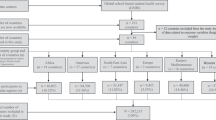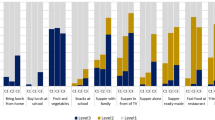Abstract
Background/Objectives:
To study the effectiveness of a multi-component intervention model of nutrition and lifestyle education on behavior modification, anthropometry and metabolic risk profile of urban Asian-Indian adolescents in North India.
Subjects/Methods:
Two schools matched for student strength and middle socioeconomic strata were randomly allocated to intervention and control group. Changes in nutrition-related knowledge, attitude, lifestyle practices, food frequency and body image of eleventh-grade students (15–17 years) in both schools were tested using a validated questionnaire. Anthropometric and biochemical measurements were made using standard methods. Segmental body composition analysis was carried out using an 8-electrode multifrequency bioelectrical impedance method of body fat estimation.
Results:
At 6 months follow-up, significant improvement in several domains of knowledge was observed in intervention children (n=99; males=60; females=39) as compared with control school children (n=102; males=61; females=41). In the intervention group, significantly lower proportion of children consumed aerated drinks (15.1%; P<0.001) and energy-dense unhealthy foods (8.9%; P=0.03), whereas significantly higher proportion brought tiffin (packed lunch) to school (14.9%; P=0.004) and brought a fruit in their tiffin (30.7%; P<0.001) as compared with the control group. Significant decrease in mean waist circumference (P=0.02, 95% confidence interval (CI)=−2.43,−0.17), sagittal abdominal diameter (P<0.001, 95% CI=−0.82,−0.09), waist-to-hip ratio (P=0.02, 95% CI=−0.03,−0.004) and fasting blood glucose (P=0.05, 95% CI=−0.09, 5.00) was seen in intervention as compared with control school children.
Conclusions:
Multi-component model of nutrition and lifestyle education was successful in improving the nutrition-related knowledge, eating habits and lifestyle practices, and resulted in beneficial changes in anthropometric and biochemical profiles of the Asian Indian adolescents. This model should be applied on countrywide basis to prevent obesity and diabetes.
This is a preview of subscription content, access via your institution
Access options


Similar content being viewed by others
References
Anderson AS, Porteous LEG, Foster E, Higgins C, Stead M, Hetherington M et al. (2005). The impact of a school based nutrition education intervention on dietary intake and cognitive and attitudinal variable relating to fruits and vegetables. Public Health Nutr 8, 650–656.
Balagopal P, Patel TG, Kamalamma N, Misra R (2008). A community-based Diabetes Prevention and Management Education Program in a rural village in India. Diabetes Care 31, 1097–1104.
Baranowski T, Cullen KW, Nicklas T, Thompson D, Baranowski J (2002). School-based obesity prevention: a blueprint for taming the epidemic. Am J Health Behav 26, 486–493.
Bhardwaj S, Misra A, Khurana L, Gulati S, Shah P, Vikram NK (2008). Childhood obesity in Asian Indians: a burgeoning cause of insulin resistance, diabetes and sub-clinical inflammation. Asia Pacific J Clin Nutr 17, 172–175.
Bhave S, Bavdekar A, Otiv M (2004). IAP National Task Force for Childhood Prevention of Adult Diseases: Childhood Obesity. Indian Pediatr 41, 559–575.
Brown T, Summerbell C (2009). Systematic review of school-based interventions that focus on changing dietary intake and physical activity levels to prevent childhood obesity: an update to the obesity guidance produced by the National Institute for Health and Clinical Excellence. Obes Rev 10, 110–141.
Delisle H (2005). Nutrition in Adolescence: Issues and Challenges for the Health: Sector Issues in Adolescent Health and Development. World Health Organization: Geneva, Switzerland.
Doak CM, Visscher TLS, Render CM, Seidell JC (2006). The prevention of overweight and obesity in children and adolescents: a review of interventions and programs. Obes Rev 7, 111–136.
Dudeja V, Misra A, Pandey RM, Devina G, Kumar G, Vikram NK (2001). BMI does not accurately predict overweight in Asian Indians in northern India. Br J Nutr 86, 105–112.
Epstein LH, Roemmich JN, Robinson JL, Paluch RA, Winiewicz DD, Fuerch JH et al. (2008). A randomized trial of the effects of reducing television viewing and computer use on body mass index in young children. Arch Pediatr Adolesc Med 162, 239–245.
Fardy PS, White RE, Haltiwanger-Schmitz K, Magel JR, McDermott KJ, Clark LT et al. (1996). Coronary disease risk factor reduction and behavior modification in minority adolescents: The PATH program. J Adolesc Health 18, 247–253.
Goenka S, Ajay VS, Jeemon P, Prabhakaran D, Varghese C, Reddy KS (2007). Powering India's Growth. World Health Organization—Government of India Collaboration: New Delhi, India.
Kain J, Uauy R, Albala, Vio F, Cerda R, Levton B (2004). School-based obesity prevention in Chilean primary school children: methodology and evaluation of a controlled study. Int J Obes 28, 483–493.
Krishnaswamy K, Bhaskaram P, Bhat RV, Ghafoorunissa, Raghuram TC, Raghuramulu N et al. (1998). Dietary Guidelines for Indians: A Manual. National Institute of Nutrition, Indian Council of Medical Research: Hyderabad, India.
Lissau I, Overpeck MD, Ruan WJ, Due P, Holstein BE, Hediger ML (2004). Body mass index and overweight in adolescents in 13 European countries, Israel, and the United States. Arch Pediatr Adolesc Med 158, 27–33.
Luepker RV, Perry CL, McKinlay SM, Nader PR, Parcel EJ, Stone LS et al. (1996). Outcomes of a field trial to improve children's dietary patterns and physical activity. The Child and Adolescent Trial for Cardiovascular Health. JAMA 275, 768–776.
Marshall DA, Vernalis MN, Remaley AT, Walizer EM, Scally JP, Taylor AJ (2006). The role of exercise in modulating the impact of an ultra low-fat diet on serum lipids and apolipoproteins in patients with or at risk of coronary artery disease. Am Heart J 151, 484–491.
Misra A, Khurana L (2008). Obesity and the metabolic syndrome in developing countries. J Clin Endocrinol Metab 93, S9–S30.
Misra A, Khurana L, Vikram NK, Goel A, Wasir JS (2007). Metabolic syndrome in children: current issues and South Asian perspective. Nutrition 23, 895–910.
Misra A, Vikram NK (2004). Insulin resistance syndrome (metabolic syndrome) and obesity in Asian Indians: evidence and implications. Nutrition 20, 482–491.
Misra A, Vikram NK, Arya S, Pandey RM, Dhingra V, Chatterjee A et al. (2004). High prevalence of insulin resistance in postpubertal Asian Indian children is associated with adverse truncal body fat patterning, abdominal adiposity and excess body fat. Int J Obes Relat Metab Disord 28, 1217–1226.
Must A, Strauss RS (1999). Risks and consequences of childhood and adolescent obesity. Int J Obes Relat Metab Disord 23, S2–S11.
Popkin BM (2001). Nutrition in transition: then changing global nutrition challenge. Asia Pacific J Clin Nutr 10, S13–S18.
Ramachandran A, Snehalatha C, Mary S, Mukesh B, Bhaskar AD, Vijay V (2006). The Indian Diabetes Prevention Programme shows that lifestyle modification and metformin prevent type 2 diabetes in Asian Indian subjects with impaired glucose tolerance (IDPP-1). Diabetologia 49, 289–297.
Rao DR, Vijayapushpam T, Subha Rao GM, Antony GM, Sarma KV (2007). Dietary habits and effect of two different educational tools on nutrition knowledge of school going adolescent girls in Hyderabad, India. Eur J Clin Nutr 61, 1081–1085.
Rush EC, Chandu V, Plank LD (2007). Reduction of abdominal fat and chronic disease factors by lifestyle change in migrant Asian Indians older than 50 years. Asia Pacific J Clin Nutr 16, 671–676.
Sahota P, Rudolf MC, Dixey R, Hill AJ, Barth JH, Cade J (2001). Randomised controlled trial of primary school based intervention to reduce risk factors for obesity. BMJ 323, 1029–1032.
Sallis JF, McKenzie TL, Alcaraz JE, Kolody B, Hovell MF (1993). Project SPARK. Effects of physical education on adiposity in children. Ann N Y Acad Sci 699, 127–136.
Shetty PS (1999). Obesity in children in developing societies: indicator of economic progress or a prelude to a health disaster? Indian Pediatr 36, 11–15.
Simonetti D’Arca A, Tarsitani G, Cairella M, Siani V, De Filippis S, Mancinelli S et al. (1986). Prevention of obesity in elementary and nursery school children. Public Health 100, 166–173.
Styne DM (2001). Childhood and adolescent obesity. PCNA 48, 823–847.
Trevino RP, Pugh JA, Hernandez AE, Menchaca VD, Ramirez RR, Mendoza M (1998). Bienestar: a diabetes risk-factor prevention program. J Sch Health 68, 62–67.
Vikram NK, Misra A, Dwivedi M, Sharma R, Pandey RM, Luthra K et al. (2003). Correlations of C-reactive protein levels with anthropometric profile, percentage of body fat and lipids in healthy adolescents and young adults in urban North India. Atherosclerosis 168, 305–313.
Wasir JS, Misra A (2004). The metabolic syndrome in Asian Indian: the impact of nutritional and socio-economic transition in India. Metab Syndr Relat Disord 2, 14–23.
Acknowledgements
This study was fully supported by grant from the World Diabetes Foundation, Denmark (WDF05-120). We express our gratitude to Dr Angeli Misra, Director, Lifeline Laboratory, for biochemical estimations. We thank TANITA CORPORATION (Tokyo, Japan) for helping us with the availability of TANITA MC-180MA. We are thankful to the children for their cooperation in the study and to the principals, teachers (Rema Alex Daniel, Ms Sheela Rao and Ms Mini Khanna) and the staff of the schools for their extended help.
Author information
Authors and Affiliations
Corresponding author
Rights and permissions
About this article
Cite this article
Singhal, N., Misra, A., Shah, P. et al. Effects of controlled school-based multi-component model of nutrition and lifestyle interventions on behavior modification, anthropometry and metabolic risk profile of urban Asian Indian adolescents in North India. Eur J Clin Nutr 64, 364–373 (2010). https://doi.org/10.1038/ejcn.2009.150
Received:
Revised:
Accepted:
Published:
Issue Date:
DOI: https://doi.org/10.1038/ejcn.2009.150
Keywords
This article is cited by
-
School-Based Interventions for Promotion of Healthy Lifestyle and Behavior: How Effective Are They?
Indian Journal of Pediatrics (2022)
-
Identifying effective intervention strategies to reduce children’s screen time: a systematic review and meta-analysis
International Journal of Behavioral Nutrition and Physical Activity (2021)
-
Community-based interventions to increase dairy intake in healthy populations: a systematic review
Public Health Reviews (2020)
-
Effectiveness of a school-based intervention on knowledge, attitude and practice on healthy lifestyle and body composition in Malaysian adolescents
BMC Pediatrics (2020)
-
Effectiveness of a school-based pilot program on ‘diabesity’ knowledge scores among adolescents in Chennai, South India
International Journal of Diabetes in Developing Countries (2020)



